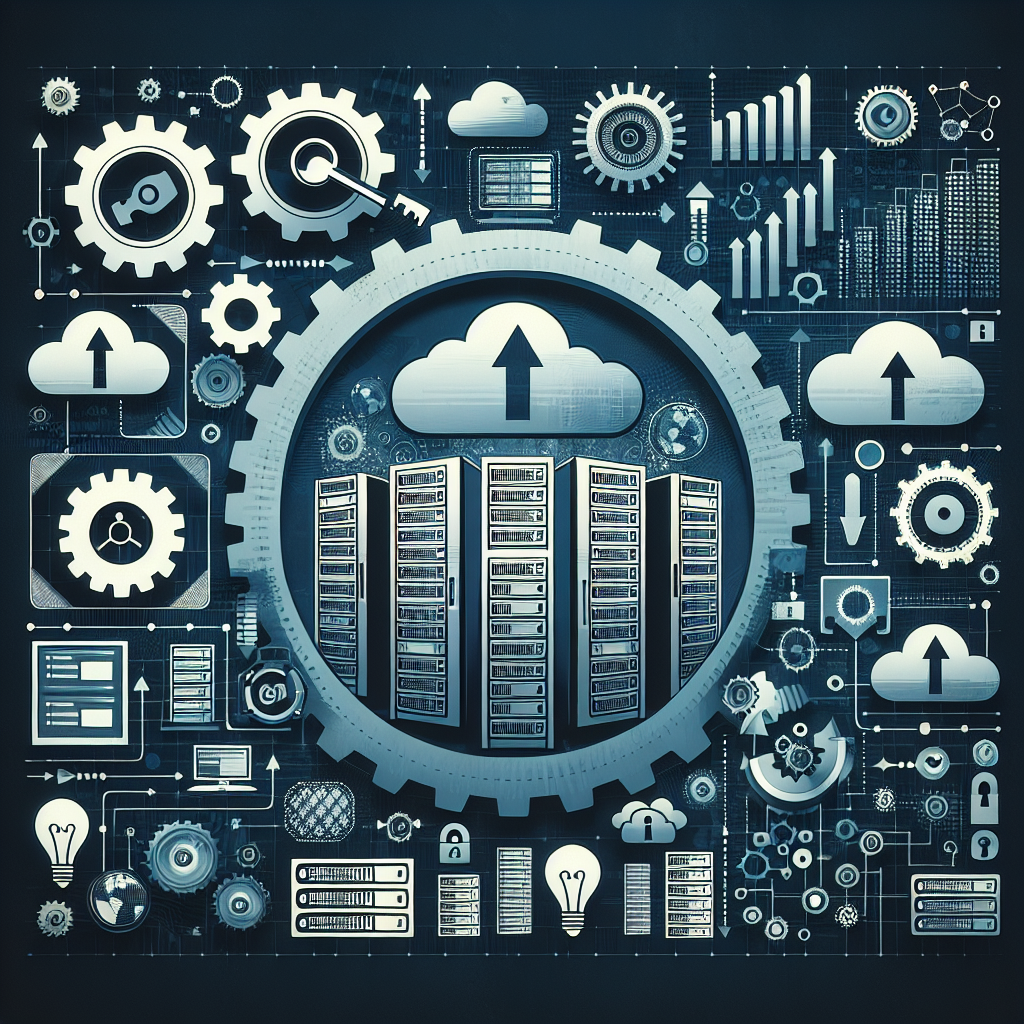Your cart is currently empty!
Tag: Data Center Performance Optimization

Driving Innovation: Implementing Data Center Performance Optimization
In today’s fast-paced digital world, data centers play a crucial role in ensuring the smooth operation of businesses and organizations. These facilities house the critical infrastructure that supports the storage, processing, and distribution of data, making them essential for the functioning of modern enterprises.With the rapid growth of data and the increasing demand for computing power, data center performance optimization has become a top priority for businesses looking to stay competitive in their respective industries. By implementing innovative strategies and technologies, organizations can maximize the efficiency and effectiveness of their data centers, leading to improved performance, reduced costs, and enhanced scalability.
One of the key drivers of innovation in data center performance optimization is the use of advanced analytics and machine learning algorithms. By collecting and analyzing data on key performance metrics such as power consumption, cooling efficiency, and server utilization, organizations can identify areas for improvement and implement targeted solutions to optimize their data center operations.
For example, predictive analytics can help organizations anticipate and address potential issues before they occur, minimizing downtime and ensuring the continuous availability of critical services. Machine learning algorithms can also be used to optimize workload placement and resource allocation, ensuring that computing resources are used efficiently and effectively.
In addition to advanced analytics, organizations can also drive innovation in data center performance optimization through the use of modular and scalable infrastructure solutions. By adopting a modular approach to data center design and construction, organizations can easily scale their infrastructure to meet changing demands, reducing the time and cost associated with traditional data center expansion projects.
Furthermore, the use of software-defined networking (SDN) and virtualization technologies can help organizations improve the flexibility and agility of their data center operations. By decoupling network functions from physical hardware, SDN allows organizations to dynamically allocate resources and optimize network performance based on real-time data and traffic patterns.
Overall, driving innovation in data center performance optimization requires a proactive approach to technology adoption and a willingness to explore new and emerging solutions. By leveraging advanced analytics, modular infrastructure, and software-defined technologies, organizations can optimize their data center operations and stay ahead of the curve in today’s rapidly evolving digital landscape.

The Key to Success: Unlocking Data Center Performance Optimization
Data centers are the backbone of modern businesses, handling the massive amounts of data that flow through organizations on a daily basis. As businesses continue to rely more heavily on digital processes, the need for efficient data center performance optimization becomes increasingly critical. By unlocking the key to success in data center optimization, businesses can ensure that their operations run smoothly, efficiently, and cost-effectively.One of the key factors in data center performance optimization is the use of advanced monitoring and analytics tools. These tools allow businesses to track and analyze data center performance in real-time, identifying bottlenecks, inefficiencies, and areas for improvement. By leveraging this data, businesses can make informed decisions about how to optimize their data center infrastructure, ensuring that it is operating at peak efficiency.
Another important aspect of data center performance optimization is the implementation of best practices for data center design and maintenance. This includes ensuring proper airflow, temperature control, and power management, as well as regularly updating and maintaining hardware and software components. By following best practices for data center design and maintenance, businesses can maximize the efficiency and reliability of their data center operations.
In addition to monitoring and maintenance, businesses can also optimize data center performance by implementing automation and orchestration tools. These tools allow businesses to streamline and automate routine tasks, reducing the risk of human error and freeing up IT staff to focus on more strategic initiatives. By automating processes such as provisioning, monitoring, and troubleshooting, businesses can improve the overall efficiency and agility of their data center operations.
Finally, businesses can unlock the key to success in data center performance optimization by investing in continuous improvement and innovation. This includes staying up-to-date on the latest trends and technologies in data center management, as well as regularly evaluating and optimizing data center processes and procedures. By fostering a culture of continuous improvement and innovation, businesses can ensure that their data center operations remain competitive and efficient in the long run.
In conclusion, the key to success in data center performance optimization lies in leveraging advanced monitoring and analytics tools, implementing best practices for design and maintenance, utilizing automation and orchestration tools, and investing in continuous improvement and innovation. By taking a holistic approach to data center optimization, businesses can ensure that their data center operations are efficient, reliable, and cost-effective, ultimately driving success and growth in the digital age.

Maximizing ROI: Strategies for Improving Data Center Performance
In today’s digital age, data centers are the backbone of many organizations, housing and managing critical data and applications that are essential for business operations. As technology continues to evolve and data volumes continue to grow, it is more important than ever for organizations to maximize the return on investment (ROI) of their data centers by improving their performance.There are several strategies that organizations can implement to improve the performance of their data centers and maximize their ROI. These strategies include:
1. Implementing virtualization technology: Virtualization technology allows organizations to consolidate servers, storage, and networking resources, reducing hardware and energy costs while increasing scalability and flexibility. By virtualizing their data center infrastructure, organizations can improve performance, reduce downtime, and increase efficiency.
2. Utilizing cloud services: Cloud services offer organizations the ability to offload some of their data center workloads to third-party providers, reducing the strain on their own infrastructure and improving performance. By leveraging cloud services, organizations can scale their resources as needed, reduce costs, and improve reliability and availability.
3. Investing in high-performance hardware: Upgrading to high-performance hardware, such as solid-state drives (SSDs), high-speed processors, and advanced networking equipment, can significantly improve the performance of a data center. By investing in the latest hardware technologies, organizations can increase processing speeds, reduce latency, and improve overall performance.
4. Implementing data center automation: Data center automation tools and technologies can streamline routine tasks, improve operational efficiency, and reduce human error. By automating repetitive tasks such as provisioning, monitoring, and maintenance, organizations can free up IT staff to focus on more strategic initiatives and improve overall data center performance.
5. Monitoring and optimizing data center performance: Regularly monitoring and analyzing data center performance metrics can help organizations identify bottlenecks, optimize resource utilization, and improve overall efficiency. By implementing monitoring tools and performance optimization strategies, organizations can proactively address issues before they impact performance and maximize the ROI of their data center investments.
By implementing these strategies and continuously monitoring and optimizing data center performance, organizations can improve efficiency, reduce costs, and maximize the ROI of their data center investments. In today’s competitive business environment, maximizing data center performance is essential for ensuring business continuity, maintaining a competitive edge, and driving growth and innovation.

Elevating Efficiency: Enhancing Data Center Performance through Optimization
Data centers play a crucial role in today’s digital world, serving as the backbone of the internet and housing the servers and equipment that store and process vast amounts of data. As more and more businesses rely on data centers to support their operations, the need for efficiency and optimization has become paramount.In order to maximize the performance of a data center, it is essential to focus on optimization strategies that can elevate efficiency and improve overall performance. By implementing these strategies, data center operators can reduce costs, increase reliability, and enhance the overall user experience.
One key optimization strategy is to maximize the use of available resources within the data center. This includes ensuring that servers and equipment are running at optimal levels, using virtualization technology to consolidate servers and reduce energy consumption, and implementing efficient cooling solutions to maintain ideal operating temperatures.
Another important aspect of data center optimization is capacity planning. By accurately forecasting future data storage and processing needs, data center operators can avoid overprovisioning and wasting resources, while also ensuring that they have enough capacity to handle growing demands.
In addition, implementing automation and monitoring tools can help data center operators identify and address potential issues before they escalate, reducing downtime and improving overall performance. By automating routine tasks and implementing real-time monitoring tools, operators can proactively manage their data center environment and make necessary adjustments to optimize performance.
Furthermore, optimizing data center networking infrastructure can also play a significant role in enhancing performance. By investing in high-speed, low-latency networking equipment and implementing efficient network design principles, data center operators can improve data transfer speeds, reduce latency, and enhance overall network performance.
Overall, by focusing on optimization strategies such as maximizing resource utilization, capacity planning, automation, monitoring, and networking infrastructure, data center operators can elevate efficiency and enhance performance. By implementing these strategies, data centers can operate more efficiently, reduce costs, and provide a better user experience for their customers.

Driving Success: Strategies for Improving Data Center Performance
In today’s fast-paced business world, data centers play a crucial role in ensuring the smooth operation of organizations. They serve as the backbone of modern technology, housing servers, storage systems, and networking equipment that are essential for storing and managing vast amounts of data. However, with the increasing demands on data centers, it is essential for organizations to continuously improve their performance to drive success.There are several strategies that organizations can employ to improve the performance of their data centers. These strategies range from optimizing hardware and software to implementing efficient cooling systems and monitoring tools. By implementing these strategies, organizations can ensure that their data centers are running at peak performance, increasing efficiency, reducing downtime, and ultimately driving success.
One of the key strategies for improving data center performance is optimizing hardware and software. This involves ensuring that the hardware and software used in the data center are up-to-date and capable of handling the demands placed on them. Organizations should regularly assess their hardware and software needs and upgrade or replace outdated equipment to ensure optimal performance.
Another important strategy for improving data center performance is implementing efficient cooling systems. Data centers generate a significant amount of heat, which can lead to overheating and equipment failure if not properly managed. By implementing efficient cooling systems, organizations can ensure that their data centers are operating at the optimal temperature, reducing the risk of downtime and equipment failure.
In addition to optimizing hardware and cooling systems, organizations should also implement monitoring tools to track the performance of their data centers. Monitoring tools can provide real-time insights into the health and performance of the data center, allowing organizations to identify and address any issues before they escalate into major problems. By monitoring key metrics such as temperature, power usage, and network traffic, organizations can proactively manage their data center performance and ensure that it is running at peak efficiency.
Overall, driving success in today’s business world requires organizations to continuously improve the performance of their data centers. By implementing strategies such as optimizing hardware and software, implementing efficient cooling systems, and using monitoring tools, organizations can ensure that their data centers are operating at peak performance, increasing efficiency, reducing downtime, and ultimately driving success. By prioritizing data center performance, organizations can stay ahead of the competition and achieve their business goals.

Unlocking the Potential: Enhancing Data Center Performance through Optimization
In today’s digital age, data centers play a crucial role in storing and managing vast amounts of information for businesses and organizations. As the demand for data continues to grow, data center performance optimization has become essential to ensuring efficient operations and meeting the needs of users.Unlocking the potential of a data center involves implementing various strategies and technologies to enhance its performance and maximize its capabilities. By optimizing key components such as infrastructure, networking, and storage, organizations can improve efficiency, reduce costs, and increase scalability.
One of the key areas of focus in data center optimization is infrastructure. This includes the physical components that make up the data center, such as servers, cooling systems, and power supplies. By consolidating servers, virtualizing resources, and adopting energy-efficient technologies, organizations can reduce their footprint, lower energy consumption, and improve overall performance.
Networking is another critical aspect of data center optimization. By implementing high-speed connections, load balancing, and traffic management tools, organizations can ensure that data is transferred quickly and efficiently between servers and users. This can help reduce latency, improve reliability, and enhance the overall user experience.
Storage optimization is also essential for maximizing data center performance. By implementing data deduplication, compression, and tiered storage solutions, organizations can improve data management, reduce storage costs, and increase accessibility. This can help ensure that data is stored and retrieved quickly and efficiently, leading to better overall performance.
In addition to optimizing individual components, organizations can also benefit from implementing automation and monitoring tools to streamline operations and improve efficiency. By automating routine tasks, organizations can free up staff time for more strategic initiatives, while monitoring tools can provide real-time insights into performance and help identify potential issues before they impact operations.
Overall, unlocking the potential of a data center through optimization is essential for meeting the growing demands of today’s digital economy. By implementing strategies to enhance infrastructure, networking, and storage, organizations can improve efficiency, reduce costs, and increase scalability. With the right tools and technologies in place, data centers can become a key asset for driving business growth and innovation.

Optimizing Your Data Center for Maximum Performance and Efficiency
In today’s digital age, data centers play a crucial role in storing and processing large amounts of data for businesses of all sizes. As technology continues to advance, the demand for efficient and high-performing data centers is only increasing. Optimizing your data center for maximum performance and efficiency is essential to ensure that it can handle the growing volume of data and meet the needs of your organization.There are several key strategies that can help you optimize your data center and improve its overall performance. By implementing these practices, you can maximize the efficiency of your data center and ensure that it operates at peak performance levels.
One of the first steps in optimizing your data center is to conduct a thorough assessment of your current infrastructure. This includes evaluating your hardware, software, and networking components to identify any bottlenecks or areas that may be slowing down performance. By identifying these issues, you can take steps to address them and improve overall efficiency.
Another important aspect of optimizing your data center is to ensure that you are using the most up-to-date technology and equipment. This includes investing in high-performance servers, storage devices, and networking equipment that can handle the demands of modern data processing. By upgrading your hardware and software, you can improve the speed and reliability of your data center and ensure that it can handle the increasing volume of data.
In addition to upgrading your hardware and software, it is also important to implement best practices for data center management. This includes regularly monitoring and analyzing performance metrics, such as server utilization, network traffic, and storage capacity, to identify areas for improvement. By proactively managing your data center and addressing any issues that arise, you can ensure that it operates at peak efficiency and performance levels.
Another key strategy for optimizing your data center is to implement virtualization and cloud computing technologies. By virtualizing your servers and storage devices, you can improve resource utilization and reduce the overall footprint of your data center. Cloud computing can also help you scale your infrastructure more easily and cost-effectively, allowing you to quickly adapt to changing business needs.
Finally, it is important to prioritize energy efficiency in your data center optimization efforts. By implementing energy-efficient cooling systems, server consolidation strategies, and other green technologies, you can reduce your data center’s carbon footprint and lower operating costs. This not only benefits the environment but also helps improve the overall efficiency and performance of your data center.
In conclusion, optimizing your data center for maximum performance and efficiency is essential for meeting the growing demands of today’s digital world. By implementing best practices for hardware and software upgrades, data center management, virtualization, and energy efficiency, you can ensure that your data center operates at peak performance levels and meets the needs of your organization. By investing in optimizing your data center, you can improve productivity, reduce operational costs, and stay ahead of the competition in today’s fast-paced business environment.

Unlocking Potential: Strategies for Improving Data Center Performance
Data centers are the backbone of modern businesses, housing the servers and storage systems that support all of our digital operations. As the demands on data centers continue to grow, it is essential to unlock their full potential in order to ensure optimal performance and efficiency.There are a number of strategies that can be implemented to improve data center performance. One of the most important steps is to regularly assess and optimize the layout and design of the data center. This includes ensuring that equipment is properly organized and spaced out to maximize airflow and reduce the risk of overheating. Additionally, it is important to regularly clean and maintain equipment to prevent dust buildup and other issues that can impact performance.
Another key strategy for improving data center performance is to invest in energy-efficient technologies. This includes upgrading to more efficient servers and storage systems, as well as implementing technologies such as virtualization and cloud computing to reduce energy consumption. By reducing the amount of power required to run the data center, businesses can not only save money on energy costs but also reduce their carbon footprint.
In addition to improving the physical infrastructure of the data center, it is also important to focus on optimizing the software and applications that run on the servers. This includes regularly updating software and firmware to ensure that systems are running at peak performance, as well as monitoring and managing workloads to prevent bottlenecks and ensure that resources are being used efficiently.
Finally, businesses can also improve data center performance by investing in training and development for their IT staff. By providing employees with the skills and knowledge they need to effectively manage and maintain the data center, businesses can ensure that their systems are running smoothly and efficiently.
Overall, unlocking the full potential of a data center requires a combination of strategic planning, investment in technology, and ongoing maintenance and optimization. By implementing these strategies, businesses can improve the performance and efficiency of their data centers, ultimately leading to better outcomes for their organization as a whole.

Elevating Performance: Tips for Optimizing Data Centers for Peak Efficiency
Data centers play a critical role in today’s digital world, serving as the backbone of the internet and housing the servers and networking equipment that support our online activities. As the demand for data continues to grow exponentially, it is essential for data center operators to optimize their facilities for peak efficiency to ensure reliable performance and minimize operational costs.One of the key factors in maximizing data center efficiency is proper planning and design. This includes selecting the right location for the facility, ensuring sufficient power and cooling capacity, and implementing a layout that allows for efficient airflow and equipment placement. By taking these factors into consideration during the initial design phase, data center operators can avoid costly retrofits and ensure that the facility is able to meet current and future demands.
Another important aspect of optimizing data center efficiency is monitoring and managing energy consumption. Data centers are notorious for their high energy usage, with cooling systems and servers accounting for the majority of power consumption. By implementing energy-efficient technologies such as hot aisle containment, variable speed fans, and energy-efficient servers, data center operators can reduce their energy consumption and lower operating costs.
In addition to energy efficiency, data center operators should also focus on optimizing server utilization. This can be achieved through techniques such as virtualization, which allows multiple virtual servers to run on a single physical server, maximizing resource utilization and reducing the number of physical servers needed. By consolidating servers and optimizing workloads, data center operators can improve performance and reduce hardware costs.
Regular maintenance and monitoring are also crucial for maximizing data center efficiency. By performing routine inspections, monitoring equipment performance, and addressing any issues promptly, data center operators can prevent downtime and ensure that the facility is operating at peak efficiency. This includes regularly cleaning and replacing air filters, checking for hot spots, and monitoring power usage to identify potential areas for improvement.
Overall, optimizing data center efficiency requires a holistic approach that takes into account factors such as design, energy consumption, server utilization, and maintenance. By implementing best practices and staying proactive in managing the facility, data center operators can ensure that their facilities are able to meet the demands of today’s digital world while minimizing costs and maximizing performance.

Boosting Productivity: Enhancing Data Center Performance through Optimization Techniques
In today’s fast-paced digital world, data centers play a crucial role in ensuring smooth operations for businesses of all sizes. These facilities house a vast amount of data and support the infrastructure necessary for organizations to operate efficiently. However, as data centers continue to grow in size and complexity, it has become increasingly important for businesses to focus on optimizing their performance to boost productivity.There are several techniques that organizations can implement to enhance the performance of their data centers and improve overall productivity. One of the key strategies is to regularly assess and optimize the layout and design of the data center. By organizing equipment and cabling in an efficient manner, businesses can improve airflow and reduce the risk of equipment overheating. This can help to prevent downtime and ensure that systems are running smoothly.
Another important aspect of data center optimization is ensuring that hardware and software are regularly maintained and updated. Outdated equipment and software can slow down performance and increase the risk of system failures. By regularly updating hardware and software, businesses can ensure that their data center is operating at peak efficiency.
In addition to hardware and software updates, businesses can also implement automation and monitoring tools to help optimize data center performance. Automation can help to streamline processes and reduce the risk of human error, while monitoring tools can provide real-time insights into system performance and help to identify potential issues before they escalate.
Furthermore, businesses can also consider implementing energy-efficient practices within their data centers to reduce costs and improve overall performance. By using energy-efficient equipment and implementing strategies such as hot/cold aisle containment, businesses can reduce their carbon footprint and lower operating costs.
Overall, optimizing data center performance is essential for boosting productivity and ensuring the smooth operation of business operations. By implementing techniques such as layout optimization, regular maintenance, automation, and energy-efficient practices, businesses can improve the performance of their data centers and drive greater efficiency across their organization.
